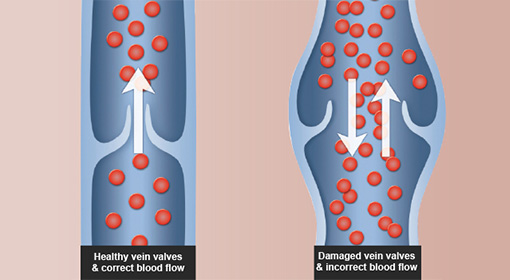
Healthy leg veins contain valves that allow blood to move in one direction from the lower limb toward the heart. These valves open when blood is flowing toward the heart and close to prevent venous reflux or the backward flow of blood. When veins weaken and become enlarged, their valves cannot close properly, which leads to venous reflux and impaired drainage of venous blood from the legs. Venous reflux is most common in the superficial veins or those veins closest to the skin. The largest superficial vein is the great saphenous vein (GSV), which runs from the top of the foot to the groin, where it attaches and drains to a deep vein called the common femoral vein.
Venous reflux can be classified as either asymptomatic or symptomatic, depending on the degree of severity. Symptomatic venous reflux disease is a more advanced stage of the disease and can have a profound impact on the patient’s quality of life. People with symptomatic venous reflux disease may seek treatment due to a combination of signs and symptoms, which may include:
Healthy leg veins contain valves that allow blood to move in one direction from the lower limb toward the heart. These valves open when blood is flowing toward the heart and close to prevent venous reflux or the backward flow of blood. When veins weaken and become enlarged, their valves cannot close properly, which leads to venous reflux and impaired drainage of venous blood from the legs. Venous reflux is most common in the superficial veins or those veins closest to the skin. The largest superficial vein is the great saphenous vein (GSV), which runs from the top of the foot to the groin, where it attaches and drains to a deep vein called the common femoral vein.
Venous reflux can be classified as either asymptomatic or symptomatic, depending on the degree of severity. Symptomatic venous reflux disease is a more advanced stage of the disease and can have a profound impact on the patient’s quality of life. People with symptomatic venous reflux disease may seek treatment due to a combination of signs and symptoms, which may include:
Spider veins, like varicose veins, are caused by dysfunctional vein valves.
View DetailsCVI is a progressive medical condition in which venous valves that help carry blood from the legs to the heart no longer function,
View DetailsDeep vein thrombosis (DVT) is a blood clot that forms in a vein deep in the body.
View DetailsVaricose veins are enlarged veins that can be blue, red or flesh colored.
View Details